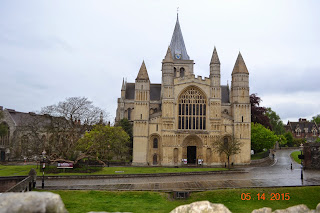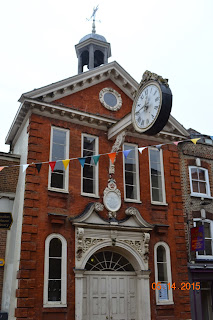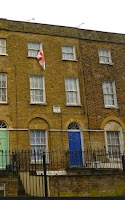I chose the town of Colchester because it is east of London and there are a few things I want to see here. I will only be here a few days. I am staying in a B&B hosted by Sara and her very old townhouse is right in the city center by an old priory ruin. I got here late in the afternoon and stayed in for the night, except for walking into the town centre for dinner.
Wednesday, I didn't go anywhere by car.....I was tired of driving. The UK highway system is interesting. Besides driving on the opposite side of the road and driving on the opposite side of the car, it takes so long to get anywhere. My destination might be 35 miles, but it might take an hour. If you aren't on the main highways, the M's (M1, M25, etc.), you are driving in the countryside. It's beautiful, but it takes so long to get anywhere. The highway infrastructure is lacking....maybe they like it that way! Anyway, I stayed in and washed clothes and got caught up on other things I needed to do. Because Sara lives in the town centre, I have to pay to park....expensive!
Thursday, I went to the area of Kent where Charles Dickens lived and did most of his writing; Chatham, Rochester, Gillingham and Higham. In Rochester, I bought a map that took me on a walk around the city marked with important buildings in his literature.
Six Poor Travellers' House, 'a clean white house, of a staid and venerable air, with a queer old door.' The Seven Poor Travellers....a short story by Dickens, in which Dickens himself, as narrator, became the seventh traveller.
Six Poor Travellers House
Eastgate House, 'Seminary for young ladies, Miss Twinkleton.' This Elizabethan mansion dates from 1590 and is featured in The Mystery of Edwin Drood as the Nuns' House, a school for young ladies and as Westgate House in The Pickwick Papers.
Eastgate House
Mister Pumblechook's House, '...eminently convenient and commodious premises'. It is featured in Great Expectations as Mr. Pumblechook's House where he carried on business as a corn chandler, and again in The Mystery of Edwin Drood as the offices of Mr. Sapsea, an auctioneer.
Mister Pumblechook's House
Restoration House, '...I began to understand that everything in the room had stopped, like the watch and the clock, a long time ago..' In Great Expectations, Dickens renamed the house, home to Miss Havisham, 'Satis House', borrowing the name from a real house near the castle. Charles II stayed there on his return to England to be crowned.
Restoration House
The Vines, '...the nooks and ruins where the monks had once had their refectories and gardens.' It is now a public park and was the vineyard of Rochester Cathedral and featured in The Mystery of Edwin Drood as the Monks' Vineyard and the route taken by Pip in Great Expectations when visiting Miss Havisham. Dickens was seen there just two days before he died.
The Vines
Minor Canon Row, featured in The Mystery of Edwin Drood, these are 18th century houses built to accommodate the minor canons and the organist of the church.
Minor Canon Row
Rochester Cathedral, '...it's like looking down the throat of Old Time..' The cathedral which is the second oldest in the country and dates from 604, is featured in The Pickwick Papers and takes center-stage in The Mystery of Edwin Drood, with the plot revolving around the ancient church and the people who worked there.
Rochester Cathedral
Rochester Castle, 'Magnificent ruin!....What a study for an antiquarian!' This Norman castle at Rochester had a humbling effect upon Dickens, reminding him perhaps of his own mortality.
Rochester Castle
The Royal Victoria & Bull Hotel, 'Good house - nice beds'. Unusually for Dickens, he used the real name of The Bull Hotel in The Pickwick Papers. Dickens himself stayed here at one time. It is also featured in Great Expectations, as The Blue Boar. It acquired the 'Royal Victoria' following an overnight stop by the Princess Victoria in 1836.
The Royal Victoria & Bull Hotel
The Guildhall, 'The hall was a queer place, I thought, with higher pews in it than a church'. It was here that Pip was brought by Mr. Pumblechook, in Great Expectations, to be bound over as an apprentice to Joe Gargery.
The Guildhall
The Old Corn Exchange, '....oddly garnished with a queer old clock that projects over the pavement....as if Time carried on business there, and hung out his sign.' The Old Corn Exchange was built in 1706 and is featured in The Uncommon Traveller and The Seven Poor Travellers. It is said that Dickens loved to look at that clock as a boy.
The Old Corn Exchange
I drove to Chatham to see one of his boyhood homes. He was born in Portsmouth, England, but lived in London and Chatham for a while as a child. His father was in the Navy and they moved often.

Left: His home at No. 2 Ordinance Terrace
Right: Plaque to commemorate Dickens
While walking as a boy with his father, he often passed Gad's Hill Place, three miles from Rochester in Higham He hoped that one day he would own this fine, though comparatively plain 18th century house. He realized his boyhood dream in 1856 when the house came up for sale and he spent the last 14 years of his life there. This is a Wiki pic because the house is now a school and it was behind gates, walls and trees! You can tell it's not mine because the sun is shining.....and it rained all day! Dickens died at Gad's Hill Place on June 9, 1870 of a brain hemorrhage and is buried at Westminster Abbey.
Gad's Hill Place
Are you tired of Dickens yet? Ha! One more tidbit...like many novelists, he is believed to have 'borrowed' some of the names for his characters from headstones in local graveyards. One such example can be seen in the small cemetery between the cathedral and St. Nicholas Church. The headstone is a memorial to the Dorrett family, which may have served as the inspiration for his novel, Little Dorritt.
Dorrett Gravestone
It really was a fun day, in spite of all the rain....On my way out of town, I turned down a street to try to turn around and this was the name of the street.....
My mother's father was George Williams, her brother is George Williams, Jr. His son is George Williams, III. and his grandson is George Williams IV. And they grew up in a town very near Chatham, VA.....hmmmmmm!
Wednesday, I didn't go anywhere by car.....I was tired of driving. The UK highway system is interesting. Besides driving on the opposite side of the road and driving on the opposite side of the car, it takes so long to get anywhere. My destination might be 35 miles, but it might take an hour. If you aren't on the main highways, the M's (M1, M25, etc.), you are driving in the countryside. It's beautiful, but it takes so long to get anywhere. The highway infrastructure is lacking....maybe they like it that way! Anyway, I stayed in and washed clothes and got caught up on other things I needed to do. Because Sara lives in the town centre, I have to pay to park....expensive!
Thursday, I went to the area of Kent where Charles Dickens lived and did most of his writing; Chatham, Rochester, Gillingham and Higham. In Rochester, I bought a map that took me on a walk around the city marked with important buildings in his literature.
Six Poor Travellers' House, 'a clean white house, of a staid and venerable air, with a queer old door.' The Seven Poor Travellers....a short story by Dickens, in which Dickens himself, as narrator, became the seventh traveller.
Six Poor Travellers House
Eastgate House, 'Seminary for young ladies, Miss Twinkleton.' This Elizabethan mansion dates from 1590 and is featured in The Mystery of Edwin Drood as the Nuns' House, a school for young ladies and as Westgate House in The Pickwick Papers.
Eastgate House
Mister Pumblechook's House, '...eminently convenient and commodious premises'. It is featured in Great Expectations as Mr. Pumblechook's House where he carried on business as a corn chandler, and again in The Mystery of Edwin Drood as the offices of Mr. Sapsea, an auctioneer.
Mister Pumblechook's House
Restoration House, '...I began to understand that everything in the room had stopped, like the watch and the clock, a long time ago..' In Great Expectations, Dickens renamed the house, home to Miss Havisham, 'Satis House', borrowing the name from a real house near the castle. Charles II stayed there on his return to England to be crowned.
Restoration House
The Vines, '...the nooks and ruins where the monks had once had their refectories and gardens.' It is now a public park and was the vineyard of Rochester Cathedral and featured in The Mystery of Edwin Drood as the Monks' Vineyard and the route taken by Pip in Great Expectations when visiting Miss Havisham. Dickens was seen there just two days before he died.
The Vines
Minor Canon Row, featured in The Mystery of Edwin Drood, these are 18th century houses built to accommodate the minor canons and the organist of the church.
Minor Canon Row
Rochester Cathedral, '...it's like looking down the throat of Old Time..' The cathedral which is the second oldest in the country and dates from 604, is featured in The Pickwick Papers and takes center-stage in The Mystery of Edwin Drood, with the plot revolving around the ancient church and the people who worked there.
Rochester Cathedral
Rochester Castle, 'Magnificent ruin!....What a study for an antiquarian!' This Norman castle at Rochester had a humbling effect upon Dickens, reminding him perhaps of his own mortality.
Rochester Castle
The Royal Victoria & Bull Hotel, 'Good house - nice beds'. Unusually for Dickens, he used the real name of The Bull Hotel in The Pickwick Papers. Dickens himself stayed here at one time. It is also featured in Great Expectations, as The Blue Boar. It acquired the 'Royal Victoria' following an overnight stop by the Princess Victoria in 1836.
The Royal Victoria & Bull Hotel
The Guildhall, 'The hall was a queer place, I thought, with higher pews in it than a church'. It was here that Pip was brought by Mr. Pumblechook, in Great Expectations, to be bound over as an apprentice to Joe Gargery.
The Guildhall
The Old Corn Exchange, '....oddly garnished with a queer old clock that projects over the pavement....as if Time carried on business there, and hung out his sign.' The Old Corn Exchange was built in 1706 and is featured in The Uncommon Traveller and The Seven Poor Travellers. It is said that Dickens loved to look at that clock as a boy.
The Old Corn Exchange
I drove to Chatham to see one of his boyhood homes. He was born in Portsmouth, England, but lived in London and Chatham for a while as a child. His father was in the Navy and they moved often.

Left: His home at No. 2 Ordinance Terrace
Right: Plaque to commemorate Dickens
While walking as a boy with his father, he often passed Gad's Hill Place, three miles from Rochester in Higham He hoped that one day he would own this fine, though comparatively plain 18th century house. He realized his boyhood dream in 1856 when the house came up for sale and he spent the last 14 years of his life there. This is a Wiki pic because the house is now a school and it was behind gates, walls and trees! You can tell it's not mine because the sun is shining.....and it rained all day! Dickens died at Gad's Hill Place on June 9, 1870 of a brain hemorrhage and is buried at Westminster Abbey.
Gad's Hill Place
Are you tired of Dickens yet? Ha! One more tidbit...like many novelists, he is believed to have 'borrowed' some of the names for his characters from headstones in local graveyards. One such example can be seen in the small cemetery between the cathedral and St. Nicholas Church. The headstone is a memorial to the Dorrett family, which may have served as the inspiration for his novel, Little Dorritt.
Dorrett Gravestone
It really was a fun day, in spite of all the rain....On my way out of town, I turned down a street to try to turn around and this was the name of the street.....
My mother's father was George Williams, her brother is George Williams, Jr. His son is George Williams, III. and his grandson is George Williams IV. And they grew up in a town very near Chatham, VA.....hmmmmmm!
















Thanks for sharing.....very interesting. I taught a Great Expectations for many years. Hope you're having a great trip. KK2
ReplyDelete